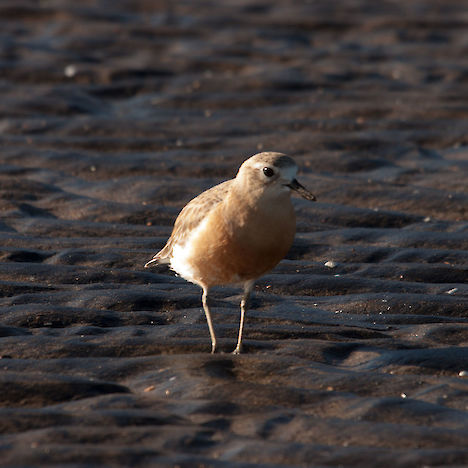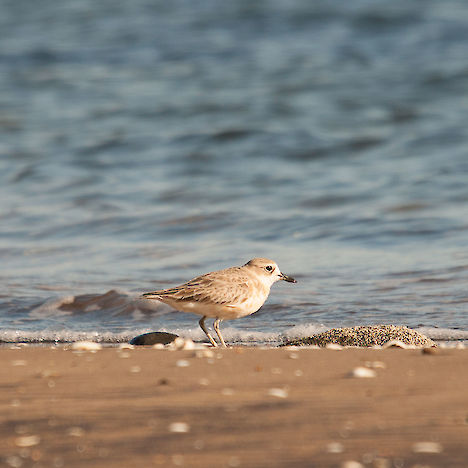Other names:
Red-breasted dotterel, tūturiwhatu, tūturiwhatu pukunui, rako, red-breasted plover, New Zealand ploverThreat category:
At Risk: Recovering?Regions:
Northland, Auckland, Waikato, Bay of Plenty, Gisborne, Hawkes Bay, Manawatu-Wanganui, Taranaki, WellingtonDistribution:
Coastally throughout much of the North Island
Identification
- New Zealand dotterels are large dotterels with a rufous chest in breeding plumage. Non-breeding adults lack the red colour, and are distinctly pale.
- Banded dotterels are smaller with a chestnut breast band in breeding plumage.
Distribution
- The Southern New Zealand dotterel nests above the bush line on Stewart Island, and migrates around the South Island coast after breeding.
- The Northern New Zealand dotterel nests on beaches from north of Taranaki around the northern coastline to Hawkes Bay. After breeding, birds either remain at their nesting area or move short distances to nearby estuaries.
- Banded dotterels breed throughout New Zealand on sandy coasts, shingle and braided riverbeds, or sometimes farmland. Birds that breed on the coasts tend not to migrate significant distances once nesting is complete. However, banded dotterels that nest on the South Island’s riverbeds mostly migrate to Australia after breeding. Others migrate to the northern North Island’s harbours and estuaries.
Interesting Facts
- The Southern New Zealand dotterel numbers approximately 250 birds and has completely disappeared from the South Island. Almost 20 years of intensive cat control has seen numbers increase substantially on Stewart Island.
- The Northern New Zealand dotterel numbers approximately 1,700 birds. At many breeding sites, community groups, other volunteers, contractors and DOC staff undertake predator control, public education, signage and roping off of breeding areas to protect breeding birds.
- Northern New Zealand dotterels nest in a scrape on the ground with little or no lining, often in relatively open dunes that are sparsely vegetated. Sometimes nests are near an obvious object like a piece of driftwood or a clump of vegetation.
- The oldest New Zealand dotterel may have lived at least 42 years.
- The banded dotterel population may be in the order of 50,000 birds, and is considered to be in decline, primarily due to the effects of introduced predators.
- Banded dotterels nest in sand, shingle, shells and dirt, and may be out in the open, or with some prostrate vegetation.
Association with Plantations
- Coastal forests may have coastal birds on forest margins.
Threats
- Human disturbance including vehicle and foot damage to nests and general interference.
- Predation, especially during nesting by mammal pests and gulls.
- Invasive plants like marram grass, lupins and wilding pines, can degrade nesting areas.
Management Options and Methods
- Minimise disturbance to nesting sites.
- Consider restricting or minimising vehicle access to important nesting sites.
- Consider removing invasive plants from dunes.
- Work with local community groups, DOC and councils to improve overall protection of important nesting sites. This could include community education, plant and animal pest control, and roping off of nesting areas and appropriate signage.
- Injured or dead coastal birds (all species):
- Place injured birds in a cardboard box in the shade and deliver to a local vet, SPCA, or DOC.
- Call DOC if bird is banded.
Monitoring Options
- Increase staff and contractor knowledge about coastal birds.
- Consider monitoring nesting sites. This could include bird or nest counts and chick survival rates.
Further Information and Support
- New Zealand Birds Online: New Zealand dotterel; banded dotterel.
- Heather and Robertson (2000). The field guide to the birds of New Zealand.
- Dowding, J.E.; Davis, A.M. 2007. New Zealand dotterel (Charadrius obscurus) recovery plan, 2004-2014. Threatened Species Recovery Plan 58. Department of Conservation, Wellington. Available online.
- Department of Conservation website: New Zealand dotterel.
- Pest management: DOC, Regional Councils.
- Local community initiatives: NZ Landcare Trust.




